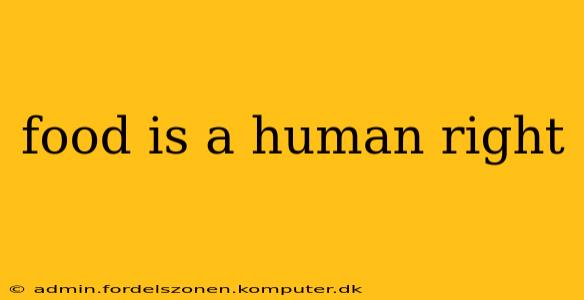Is Food a Human Right? A Deep Dive into Access, Equity, and Dignity
The question of whether food is a human right is not merely a philosophical debate; it's a critical issue impacting billions globally. While not explicitly enshrined in a universally ratified international human rights treaty like the Universal Declaration of Human Rights (UDHR), the right to adequate food is widely recognized as a fundamental human right by numerous international bodies and legal frameworks. This recognition stems from a profound understanding that access to sufficient, safe, and nutritious food is essential for survival, dignity, and the full enjoyment of other human rights.
This article explores the multifaceted nature of this right, delving into its implications and the challenges in ensuring its realization for everyone.
What does "the right to food" actually mean?
The right to food isn't simply about having enough calories to survive. It's a comprehensive right encompassing several key elements:
- Availability: Sufficient quantities of food must be available at all times. This requires robust food production and distribution systems capable of meeting the needs of the population.
- Accessibility: Food must be accessible to all, regardless of their economic status, location, or any other discriminatory factors. This involves affordability, physical access, and the ability to utilize food (e.g., having cooking facilities).
- Adequacy: Food must be adequate in terms of quality, quantity, and diversity to meet nutritional needs and ensure a healthy and active life. This goes beyond simply preventing starvation; it's about promoting well-being.
- Acceptability: Food should be culturally acceptable, meaning it respects individual dietary needs and preferences. This acknowledges the importance of food in cultural identity and traditions.
Where is the right to food enshrined?
While the UDHR doesn't explicitly mention "the right to food," Article 25 guarantees the right to "a standard of living adequate for the health and well-being of himself and of his family, including food." This foundational principle has been further elaborated upon in subsequent international human rights instruments, including:
- The International Covenant on Economic, Social and Cultural Rights (ICESCR): Article 11 explicitly recognizes the right to an adequate standard of living, including the right to food.
- The Convention on the Rights of the Child (CRC): This treaty emphasizes the right of children to adequate nutrition as essential for their survival and development.
Numerous regional and national legal frameworks also reflect this commitment.
How is the right to food enforced?
Enforcing the right to food presents significant challenges. It requires a multifaceted approach involving:
- Governmental Action: States have a primary responsibility to create enabling environments through policies and programs aimed at improving food security and addressing hunger. This includes investing in agriculture, social protection programs, and equitable access to resources.
- International Cooperation: International organizations like the FAO (Food and Agriculture Organization of the United Nations) play a crucial role in monitoring progress, providing technical assistance, and advocating for policy changes.
- Civil Society Engagement: NGOs, community-based organizations, and advocacy groups play a vital role in raising awareness, monitoring human rights violations, and holding governments accountable.
What are the biggest obstacles to realizing the right to food?
Despite international recognition, the right to food remains a significant challenge for millions. Key obstacles include:
- Poverty and Inequality: Lack of economic resources is the most significant barrier to access.
- Conflict and Instability: Armed conflicts disrupt food production, distribution, and access.
- Climate Change: Extreme weather events and environmental degradation negatively impact food production and availability.
- Political Instability and Corruption: Weak governance and corruption hinder effective implementation of policies and programs.
What can be done to ensure food is a reality for everyone?
Realizing the right to food requires a concerted and sustained effort from all stakeholders. This involves:
- Investing in sustainable agriculture: Promoting climate-resilient farming practices and supporting smallholder farmers.
- Strengthening social protection programs: Implementing effective safety nets such as food assistance programs and cash transfers.
- Addressing inequality and poverty: Implementing policies aimed at reducing poverty and promoting economic justice.
- Promoting good governance and transparency: Combating corruption and ensuring accountability in food governance.
- Raising awareness and advocacy: Educating the public about the right to food and advocating for policy changes.
The right to food is not merely a matter of charity; it's a fundamental human right essential for a just and equitable world. Achieving food security for all requires a collective commitment to addressing the underlying causes of hunger and malnutrition and ensuring that everyone has access to sufficient, safe, and nutritious food. Only through concerted global effort can we transform the aspiration of food as a human right into a tangible reality.
